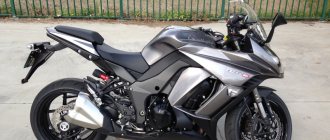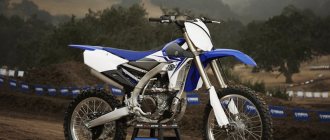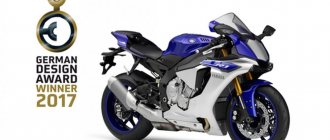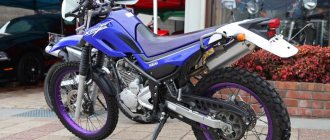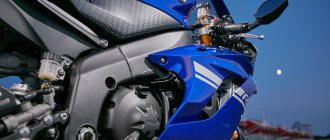Description
The Yamaha GTS 1000 sports touring motorcycle model was first presented in 1992 at the IFMA exhibition in Cologne, and went into production in 1993. The model was based on the engine from the sports version of the Yamaha FZR 1000, which was seriously derated, retuned and an injector was added instead of carburetors, achieving not only confident traction at low speeds, but also linear performance throughout the entire operating range. As a result, the engine, which originally produced 145 hp, began to produce up to 100 hp. (depending on the country of sale) power and 106 Nm of torque, fully available at 6500 rpm.
However, the main feature of the Yamaha GTS 1000 was the unique front suspension, which is a cantilever wheel mounting system with special rods and hinges responsible for steering and damping. This suspension system was called RADD and was developed by James Parker. Among the advantages, it should be noted record rigidity, stability and lack of dive when braking. This is especially noticeable on uneven roads. However, the disadvantages crossed out all the advantages of this design - an increase in unsprung mass (compared to a classic fork, the difference was significant - 31.6 kg versus 21.5 kg), the ambiguous nature of left and right turns, the higher cost of the design and practically non-existent maintainability ( in the event of an accident, not only the main suspension arm could bend, but also the frame itself). The 130 mm wide front wheel also worsened the handling of the motorcycle, however, despite extensive criticism, the motorcycle continued to be sold almost unchanged until 1999.
Increased fuel consumption also raised many questions. According to numerous tests, fuel consumption when driving on the autobahn could reach more than 10 liters per 100 km, which was too much for a touring motorcycle. The reason for this, of course, was the Genesis sports engine, which, although it had undergone noticeable changes, was still not fully optimized for touring.
On top of that, the Yamaha GTS 1000 model was equipped with a chain drive, which was less suitable for touring purposes compared to the traditional cardan for motorcycles of this class.
Meanwhile, the Yamaha GTS 1000 model had its advantages. Of these, we can highlight advanced wind protection and a successful design of mirrors, an informative dashboard, adjustable suspension, an injector and, most notably, the availability of versions with ABS.
In 2006, Bike magazine awarded the Yamaha GTS 1000 the title of one of the most interesting rare motorcycles.
Thus, the Yamaha GTS 1000 model received many mixed reviews from users and experts. On the one hand, this is a very interesting, unique and technologically advanced motorcycle for its time. But on the other hand, it was subjected to enormous criticism and was not understood everywhere. For example, the model was sold on the US market for only a year, until 1994, after which it was not officially supplied there. Only 1,369 motorcycles were sold in Germany. Low demand forced Yamaha to abandon production of the GTS 1000 in 1997, but sales of the remaining new motorcycles continued in some countries until 1999. In Russia, this motorcycle is considered quite rare; there are literally a couple of copies on the used motorcycle market.
Flaws:
- High cost of acquisition and operation.
- The front suspension has a non-standard design, so the behavior of the motorcycle when turning in different directions may be different. In addition, this type of suspension is afraid of direct impacts from the front. Often, after an accident, it is quite difficult to restore a motorcycle, since the frame may be damaged.
- Frequent braking can cause the pads to overheat.
- Not suitable for city driving due to its large dimensions and weight. When driving within the city, it is necessary to adjust the mirror system.
The Yamaha gts 1000 tourer is not widely used due to its high price and operating costs. However, its reliability and technical characteristics have no competitors even now, despite the fact that it was produced 20 years ago. It has a unique design, power, and speed. It is chosen by people who are used to traveling by motorcycle.
Brief history of the model
1993 - start of production and sales of the Yamaha GTS 1000 model. Model: Yamaha GTS1000 + ABS (North America, Europe, Oceania). Factory designation: 4BH1, 4BH2, 4FE1, 4FV1, 4FV2, 4HH3; GTS1000AE, GTS1000AEC (North America).
1994 is the last year of sales in the US market. Model: Yamaha GTS1000 + ABS (North America, Europe, Oceania). Factory designation: 4BH3, 4BH4, 4FE3, 4FE4, 4FV3, 4FV4, 4HH6; GTS1000AF, GTS1000AFC (North America).
1995-1997 - the model is not produced. 1998 is the last year of production. Model: Yamaha GTS1000 + ABS (Europe, Oceania). Factory designation: 44BH6, 4BH7, 4FE6, 4FE7, 4FV5, 4FV6.
Yamaha GTS 1000 price based on sales advertisements
The maximum price of Yamaha GTS 1000 among the advertisements found is RUB 900,000*
The average price of Yamaha GTS 1000 among the ads found is RUB 186,000*
The minimum price of Yamaha GTS 1000 among the advertisements found is 6,000 rubles*
Selling Yamaha GTS 1000 in Taldom
11/20/2020 185,000 rub.
Yamaha GTS 1000 in Smolensk
11/16/2020 185,000 rub.
Yamaha gts 1000 in Shakhovskaya
09.09.2020 120,000 rub.
Yamaha GTS 1000A in Moscow
02/14/2020 155,000 rub.
Selling a Yamaha GtS 1000 sport-tourist motorcycle in Abakan
09/14/2019 140,000 rub.
Yamaha GTS1000 in Solnechnogorsk
07/23/2019 155,000 rub.
Yamaha GTS 1000 in Mytishchi
07/18/2019 178,000 rub.
Yamaha GTS 1000 motorcycle in Zelenokumsk
06/17/2019 220,000 rub.
Yamaha GTS1000 4BH-001163 1997 in Vladivostok
06/17/2019 169,000 rub.
Yamaha GTS 1000 with a unique front fork in Livny
06/13/2019 RUB 269,999
Yamaha GTS1000A in Naberezhnye Chelny
06/11/2019 149,000 rub.
Yamaha gts 1000 in Palekh
09/04/2017 160,000 rub.
Yamaha gts 1000 in Moscow
08/21/2017 155,000 rub.
Yamaha GTS1000 MCW Edition in Samara
02.08.2017 900,000 rub.
Yamaha GTS 1000 for sale in Livny
07/03/2017 250,000 rub.
Selling Yamaha GTS 1000 1993 in Voronezh
03/07/2017 250,000 rub.
Selling Yamaha GTS 1000 ABS 1993 in Orel
02/28/2017 250,000 rub.
Yamaha GTS 1000 Yamaha GTS 1000 in Moscow
02/03/2017 175,000 rub.
Yamaha GTS 1000 trike in Yelabuga
01/20/2017 85,000 rub.
Yamaha GTS 1000 A in Maykop
11/23/2016 200,000 rub.
Yamaha GTS 1000 abs in Moscow
11/16/2016 200,000 rub.
Yamaha GTS 1000 in Moscow
11/16/2016 200,000 rub.
Yamaha GTS 1000 in Chelyabinsk
08/19/2014 150,000 rub.
Yamaha GTS1000 1997 in Vladivostok
08/05/2014 150,000 rub.
Yamaha GTS1000 in Moscow
08/01/2014 150,000 rub.
Complete set of engine gaskets for Yamaha GTS1000 in Obninsk
06/25/2014 6,500 rub.
Steering gear Yamaha GTS1000 in Obninsk
06/25/2014 7,000 rub.
Steering knuckle for Yamaha GTS1000 in Obninsk
06/25/2014 12,000 rub.
* Attention! Under the maximum, average and minimum of the Yamaha GTS 1000 motorcycle on this page, the average cost according to advertisements for sale on the Internet is indicated, without taking into account the year of manufacture, configuration and generation of the motorcycle model.
Specifications:
| Model | Yamaha GTS1000 |
| Motorcycle type | sports tourist |
| Year of issue | 1993-1998 |
| Frame | aluminum tubular |
| engine's type | 4-cylinder, 4-stroke, in-line |
| Working volume | 1003 cm³ |
| Bore/Stroke | 75.5 x 56.0 mm |
| Compression ratio | 10.8:1 |
| Cooling | liquid |
| Number of valves per cylinder | DOHC, 5 valves per cylinder |
| Fuel supply system | injector, 4x Mikuni AC34 |
| Ignition type | transistor TCI |
| Maximum power | 100.0 hp (73.5 kW) at 9000 rpm |
| Maximum torque | 106 Nm (10.7 kg*m) at 6500 rpm |
| Transmission | 5-speed |
| type of drive | chain |
| Front tire size | 130/60 ZR17 |
| Rear tire size | 170/60 ZR17 |
| Front brakes | 1 disc, 330 mm, 6-piston caliper (ABS) |
| Rear brakes | 1 disc, 282 mm, 2-piston caliper (ABS) |
| Front suspension | cantilever pendulum RADD (adjustment of preload, compression and rebound), stroke - 116 mm |
| Rear suspension | pendulum with monoshock absorber (adjustable preload, compression and rebound), stroke - 130 mm |
| Motorcycle length | 2165 mm |
| Motorcycle width | 700 mm |
| Motorcycle height | 1255 mm – glass in the lower position 1320 mm – glass in the upper position |
| Wheelbase | 1495 mm |
| Seat height | 790 mm |
| Minimum ground clearance (clearance) | 135 mm |
| Acceleration to 100 km/h | 3.8 sec |
| Maximum speed | 230 km/h |
| Gas tank capacity | 20.0 l (including reserve - 3.5 l) |
| Motorcycle weight (curb) | 279 kg |
Detailed review
It’s nice to see when speed characteristics and excellent cross-country ability are delicately combined in one scooter. 100 cc allows you to fully experience the speed, leaving cars behind in traffic jams of the “concrete jungle”. The scooter is very maneuverable, it is easy and pleasant to drive. Even a small child can handle the controls.
Don't forget about the suspension, which has undergone long-term and high-quality work. It is necessary to note its travel: at the rear it is 55 mm, and at the front 70 mm. Delving deeper into the shock absorption system, it is necessary to say the following: all loads, vibrations and shaking from the rear are “absorbed” by the pendulum suspension, which is articulated with the engine. At the front, a standard telescopic fork is used.
A reliable braking system is one of the key positions in any vehicle, and a scooter is no exception. In this case, the developers installed disc and drum brakes at the front and rear, respectively (with a diameter of 150 mm and 130 mm).
Let's move on to the design of the sensational model. The designers have done everything possible to distinguish the Bws 100 from all other scooters in this class. They succeeded in this to the fullest. Looking at the Yamaha from the front, a non-standard solution immediately catches your eye - headlights for illumination at night. This component is made in a non-standard format; it is double. This only had a positive effect on the quality of consecration. We can safely say that the design is completely sporty. This is indicated by smooth, interesting shapes. In addition, it is worth highlighting the sports wheels and the appropriate fit. The “Japanese” is not only truly nimble, but also quite practical. There is a small luggage area at the rear, and there is a trunk under the seat. Below the steering wheel there is a glove compartment. Long trips are pleasant and comfortable with a soft, 2-seater seat. There are mirrors on the sides to control movement. A 100 cc scooter from Yamaha is an ideal purchase for young and energetic people who love fast riding.
Touring motorcycle Yamaha Tracer 900 GT 2022
Yamaha Tracer 900 GT 2019
But let's take things in order. Last year, Yamaha updated the FJ-09 sport tourer and renamed it Tracer (which is what the model has been unofficially called since its introduction in the 2022 model year). Then came the GT package with hard cases, heated grips and cruise control.
Performance-wise, the Tracer 900 GT appears to be the ideal touring motorcycle, combining sport-touring functionality with modern ergonomics and design. For those who have long been looking for a motorcycle with an upright riding position in the tourenduro style, but did not need off-road features at all, the Yamaha Tracer GT is simply an ideal option, along with the Kawasaki Versys 1000, occupying the niche of a budget competitor for the more expensive MV Agusta Turismo Veloce, KTM Super Duke GT and Ducati Multistrada 950.
Engine
A lot has already been said about the three-cylinder in-line engine with which the Yamaha Tracer 900 is equipped, and it is deservedly appreciated. It's torquey, spins well, and sounds like it has a nest of giant hornets inside. If you haven't driven a 3 before, you probably think it's somewhere between a 2 and a 4. Not quite so: the three is almost the same as the four, almost the same torque, but a little more torquey at the bottom, and more bassy when compared within the same cubic capacity.
Yamaha Tracer 900 GT 2019
Even so, there are vibrations, especially up to 6000 rpm, which makes the small mirrors rather useless on the move. The box shifts very smoothly, and the quickshifter (up only) works flawlessly.
The response to the throttle can be changed between three modes: STD (standard, of course), A (aggressive) and B (soft). The names are certainly counter-intuitive, but you get used to them quickly. Mode A makes the engine quite sharp, and given that the in-line three is not very slow anyway, in this mode the motorcycle takes on a truly sporty and explosive character.
Touring motorcycle
My partner asked me to note in the article that for a sports tourist the Tracer has harsh suspensions that provide very controlled steering during aggressive driving, but for a quiet ride I would like it to be a little softer. Wind protection is minimal, so the wind blows quite noticeably at highway speeds. More cons? The dashboard is a bit small, and the remote controls are both complex and awkward. The trunks do not fit anything larger than a city backpack and a change of clothes. It sounds like we're nitpicking, but we're talking about the GT, right? And these points are important for a touring motorcycle.
Overall, the Yamaha Tracer GT is the benchmark Yamaha in every way. Every aspect of the ride is impeccably precise - throttle, shifting, steering. It is controlled literally by the power of thought, and at the same time it does not feel like a roll or loose. Add to this a 24-degree headset, a fairly short wheelbase, a rigid aluminum frame and tight suspension - and you will understand how close the Tracer GT is to the Yamaha R-s.
While we were getting ready for the trip and our photographer was taking photos on the road, we were discussing the Yamaha Tracer GT. And we came to the conclusion that this is a good motorcycle, very correct, but it is neither this nor that. It's not as exciting as a sportbike or naked bike (on which it's broadly based), and its edgy nature isn't exactly conducive to relaxed touring. Objectively, the Tracer GT is a great bike, but its hypernaked sharpness feels strange and even harsh in a touring bike form factor.
Origin of the company
The origin of the company dates back to 1887. It was founded by T. Yamaha. The company was called Nippon Gakki at the time (renamed Yamaha Corporation in 1987). Initially, the Japanese manufacturer produced musical instruments, such as harmoniums, pianos, and harmonicas. In 1889, the production of Western musical instruments was opened.
The company began manufacturing furniture in 1903, applying its skills in wood processing. When World War I began, trade in musical instruments with Japan was closed. But the company was able to take advantage of this, completely covering the domestic market. It produced musical instruments on a large scale and had about 1,000 full-time employees.
The expansion of production and the development of new areas of activity for the company occurred in 1920. Production of propellers for aircraft began. This despite the fact that the company has lost its founder. But thanks to a strong team in the administration, the manufacturer continued to operate.
Yamaha has experienced many ups and downs during its hundred-year history. At the end of World War II, the Japanese government confiscated Nippon Gakki, which produced metal products. But in 1954 the company was returned to the owners. Since that time, the production of motorcycles began. And on July 1, 1955, the line for the production of such vehicles was separated into an independent company, known today as Yamaha. It was controlled by Genichi Kawakami.
The first model of this manufacturer was copied from the DKW RT 125 and was called the Yamaha YA-1 and received the nickname “red dragonfly”. It was after this model that the company became famous. The motorcycle won the first competition in a race at the foot of Mount Fuji.
The production of the Japanese brand began to expand. In 1959, the company launched a line of motor boats made from fiber-reinforced material.
The company expanded quite quickly. In 1964, a motorcycle production plant was built in Thailand, then in 1966 in Taiwan.
Over time, the company began producing snowmobiles and snow removal equipment. The company launched a line for this production in 1968. Yamaha also created robots in 1975 for welding work.
After the Japanese manufacturer mastered the market in the United States, by the end of 1970 it ranked second in the world in motorcycle production. Since the beginning of the 80s, the company competed strongly with the Honda plant. She made attempts to oppress and defeat her competitor.
Since 1982, the company has created partnerships with a French manufacturer to produce scooters.
Development did not stop. Production capacity continued to expand. Since 1985, Yamaha began its operations in India. There are currently two factories operating there. Partnerships were also established with Italian motorcycle manufacturers Minarelli, and since 2002 this company has joined the ranks of Yamaha Motor. In those same years, one of the famous motorcycle models, the Yamaha FZS 1000, was released.
As you can see, the manufacturer has a hundred-year history and limitless experience. Today they produce:
- motorcycles;
- bicycles;
- outboard motors;
- engines for cars;
- all-terrain vehicles;
- golf carts;
- snowmobiles;
- electric generators;
- robots for industry;
- other.
This brand is known and recognized all over the world. The Japanese manufacturer is known for its quality. Therefore, the demand for these products is always high.
Review
The Yamaha TRX 850 is equipped with a ten-valve two-cylinder engine with a dry sump, which is a modification of the TDM850 engine. The second generation TDM is similar to the TRX unit in alternating flashes at 270°, but differs in carburetor and camshaft settings. The character inherent in sportbikes is fully manifested in the operation of the engine: power delivery is even and smooth, traction is maintained throughout the entire speed range. Power units are characterized by minimal vibration loading, which is very unusual since the nature of the operation is similar to engines with a 90-degree cylinder camber.
The frame of the Yamaha TRX 850 sports motorcycle is made of steel pipes and its design resembles the signature Ducati “birdcage”. The original appearance of the frame is not its only advantage: it has excellent rigidity. The sporty nature of the chassis is emphasized by brakes and suspension borrowed from the Yamaha FZR motorcycle range. The rear shock absorber and front fork are equipped with a wide range of settings. The Brembo braking system features 320mm front discs with two four-piston calipers and a rear two-piston caliper.
The motorcycle seat is flat, comfortable and quite spacious, allowing you to change the seating position on long trips by moving the driver back and forth. Hard seat cushions can somewhat spoil long trips, which, however, can be easily fixed by replacing the seat.
The Yamaha TRX 850 was discontinued in 1999. Over all the years of production, it has not undergone any changes.
Advantages and disadvantages
Based on the characteristics of the Yamaha FZS 1000, we can safely note the following advantages:
- maneuverability is excellent both at speed and in traffic jams;
- power is easily controlled;
- The braking system is excellent;
- There are no problems with consumables, everything can be found on sale;
- sufficient choice for tuning Yamaha FZS 1000;
- reliability and quality;
- comfortable fit for city and long trips;
- good weight distribution;
- panoramic view of mirrors at 5;
- Without much effort, the dashboard is easily customizable.
The disadvantages include the following facts:
- after factory assembly, it is worth checking all the tightening nuts;
- the tank is only 17 liters, if you do not take into account the reserve four liters (a larger volume could be installed);
- high tax (about 7,500 rubles per year).
The model's shortcomings cannot overshadow its advantages. That's why the bike is still popular today.



